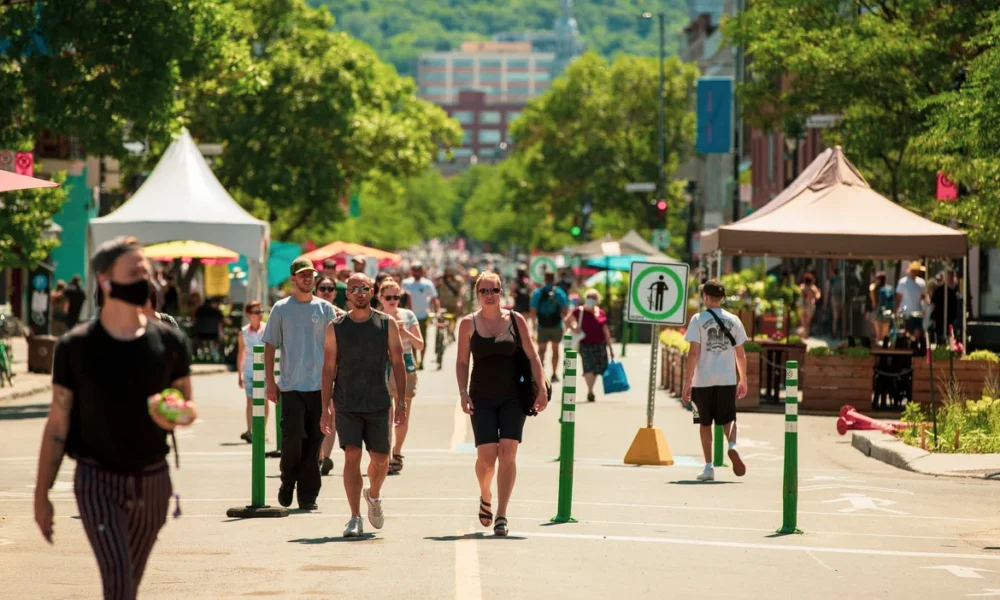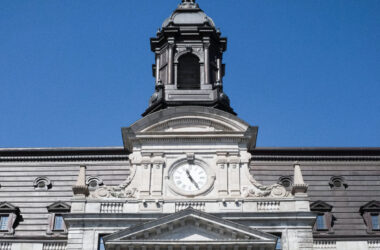It’s a beautiful day: Birds chirping overhead, cyclists zooming by, neighbours and shopkeepers chatting, people enjoying shawarma and poutine on benches. No, you’re not in a park. You’re in the middle of the Plateau, on Mont-Royal Avenue—and there are no carbon-dioxide–spewing vehicles in sight.
Montreal’s pedestrian-only streets, which can be found across the island from Verdun to Little Italy, create a unique ambience that gives the city its charm, beauty, and grit. Car-free spaces provide significant social and economic benefits, and on top of that, more space for bikes and pedestrians encourages people to ditch their cars, lowering the city’s carbon footprint. Montreal’s pedestrian streets are a great example of smart urbanism, and the city ought to expand the program and make the pedestrian streets a year-round phenomenon. Further, other North American cities should take a page out of Montreal’s book and develop their own pedestrian street programs.
Montreal’s long-term, summer-wide pedestrian streets were initially conceived to provide space for outdoor social interaction during the COVID-19 pandemic. Due to the popularity of the program and its economic benefits, such as increased business activity and rising property values, the city chose to extend it. Mayor Valérie Plante announced in April that the city would be spending $12 million to pedestrianize streets over the next three summers.
Pedestrian streets, along with their aesthetic and environmental benefits, are an economic boon for cities. According to Luc Rabouin, the mayor of the Plateau-Mont-Royal borough, the pedestrianization of Wellington Street last summer brought in 17 per cent more shoppers and visitors. Furthermore, average property values along a street rise as the street becomes more walkable. Compared to the auto-oriented sections of cities and towns, walkable areas bring in more taxes due to a higher rate of economic activity.
This is only common sense: As streets become safer and more inviting, people choose to shop and walk along them. They spend more time passing storefronts and perusing windows. The streets become social and economic hubs, tying neighbourhoods together.
Considering their environmental benefits, it’s hard to see why some people might oppose efforts to pedestrianize cities. While critics posit that the reduced space for cars disincentivizes economic activity, studies have shown that travellers that walk or take public transit spend more per month at local businesses than drivers. Critics also argue that pushing cars off main thoroughfares will intensify traffic elsewhere in the city. However, when cities prioritize walking and public transit, people are encouraged to switch from driving to these alternatives, meaning traffic levels in the city should decrease because fewer people are using their cars. This effect has been demonstrated in cities such as New York City and Madison, Wisconsin.
One concern that’s especially pertinent for Montreal is that, if the pedestrian streets remained open all year round, they wouldn’t see use in the cold months. But just as Montrealers flock to parks when the snow falls with their sleds, skis, and skates, they would take advantage of car-free streets, too.
Montreal’s pedestrianization pilot program is a step in the right direction—hopefully Toronto and Vancouver will follow suit. But the program should be greatly expanded. First, the pedestrian streets should become permanent parts of the cityscape, not just summer treats. Imagine the convenience and advantages that would come with pedestrian and bike-friendly avenues crisscrossing the city year-round. Projects in cities such as New York City and Boston have transformed ugly and congested streets into mixed-use transit, bike, and pedestrian boulevards. Montreal should also create more public squares, which yield many of the same benefits as pedestrian streets. At some of the most notorious and awkward intersections in New York City where diagonal streets meet the grid, cars are pushed to the side to make way for pedestrian-friendly plazas. It’s fairly cheap to do this: Some new street furniture, lighting, planter boxes, and sidewalk paint or pavers will do the trick.
Considering how easy and beneficial it is to reorient cities from cars to people, Montreal should double down on its efforts and continue to prove that it’s the coolest city in Canada.









